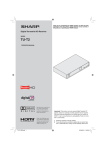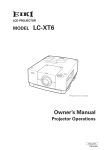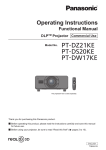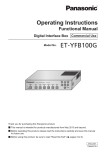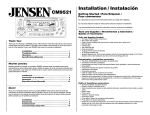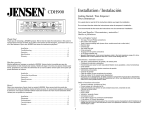Download A USER GUIDE ON HOW TO DESIGN, FINANCE AND RUN A
Transcript
A USER GUIDE ON HOW TO DESIGN, FINANCE AND RUN A ROYAL SOCIETY (OR INDEED ANY OTHER) EXHIBITION Prof. Chris Budd, Dept of Mathematics, University of Bath HE STEM A user guide on how to design, finance and run a Royal Society (or indeed any other) Exhibition Author A user guide on how to design, finance and run a Royal Society (or indeed any other) Exhibition Prof. Chris Budd, Dept of Mathematics, University of Bath Photos by Karin Mora, University of Bath Tel: 01225 386241 Fax: 01225 386492 e-mail: [email protected] The Intellectual Property Rights (IPR) for the material contained within this document remains with its respective author(s) “A user guide to how to design, finance and run a Royal Society (or indeed any other) Exhibition” by Professor Chris Budd is licensed under a Creative Commons AttributionNonCommercial-NoDerivs 3.0 Unported License. © The University of Birmingham on behalf of the National HE STEM Programme ISBN 978-0-9567255-2-3 Disclaimer This document does not purport to be comprehensive. Whilst every effort has been made to ensure that the information herein contained is accurate, no responsibility can be accepted for any errors, omissions or inaccuracies contained within the document. Readers should not rely, act or refrain from acting upon information in this document without first taking further advice. Aim The National HE STEM Programme is an initiative funded by the Higher Education Funding Councils for England and Wales through an activity grant to the University of Birmingham in June 2009. The programme is co-ordinated through six regions, each represented at universities including the Universities of Bath, Birmingham, Bradford, Manchester Metropolitan, Southampton and Swansea, and works in partnership with four Professional Body Partners (The Institute of Mathematics and its Applications, The Institute of Physics, The Royal Academy of Engineering, and the Royal Society of Chemistry). Working across the higher education sector with a particular focus upon the disciplines of Chemistry, Engineering, Mathematics and Physics,the National HE STEM Programme supports higher education institutions in encouraging the exploration of new approaches to recruiting students and delivering programmes of study. It enables the transfer of best practice across the higher education STEM sector, facilitates its wider adoption and encourages innovation. Through collaboration and shared working, the Programme focuses upon sustainable activities to achieve long-term impact within the higher education sector. As part of this philosophy The National HE STEM Programme actively disseminates project outcomes and evidence based good practice to HEIs beyond those involved in the project. June 2011 Published by The National HE STEM Programme, University of Birmingham, Edgbaston, Birmingham B15 2TT [email protected] www.hestem.ac.uk 2 HE STEM A user guide to how to design, finance and run a Royal Society (or indeed any other) Exhibition Introduction If you are reading this, then it is likely that you have been selected to run a Royal Society Summer Exhibition. In fact, you may even be reading this if you have been selected to run an interactive session at any form of fair, festival or exhibition. This might be nationally, within your local region, or within your own school or institution. While this guide has been written based upon the experience of my team at the 2010 Royal Society Summer Exhibition (part of the Royal Society’s 350th anniversary celebrations no less!), it is equally applicable to any activity where hands on and interactive demonstrations are required. Firstly the good news. Well done! This is an amazing experience and gives you a fantastic opportunity to communicate the excitement that you feel about your work to a huge and varied audience. My team ran a mathematics centred exhibition called ‘Living in a Complex World’ in the summer of 2010 and this report will describe some of the experiences that we had doing this. The Royal Society estimated that 50,000 people came to the Summer Exhibition, including families, school students, the press, politicians, people from all over the world and the Queen. It is unlikely that we will ever have such an exposure of our work again. Now for the bad news! Running such an exhibition is immensely hard work that requires very careful preparation, military style planning and organisation, and a large, dedicated and tireless team to make it happen. After two weeks of running the exhibition you will probably never again want to talk to anyone, ever! But for all that, it is hugely worthwhile. Mathematical exhibitions have their own issues, as mathematics is a challenging subject to demonstrate to a general and varied audience, and I will discuss these issues in this manual. However, the general principles that I will cover will apply to any exhibition on a science related theme. Above all, I hope that this guide will give you some hints as to how to set up and run a large exhibition and the sort of team, training, preparation and budget that you will need. I hope that this guide also conveys some of the fun, excitement and energy that we had during the exhibition. It is my pleasure to thank everyone who worked together to make the exhibition possible, which includes my team at Bath, the Royal Society team and everyone that supported us both financially and with great ideas. As a warm up exercise to reading this guide, see if you can do the puzzle on the page below 3 HE STEM A user guide on how to design, finance and run a Royal Society (or indeed any other) Exhibition What is the Royal Society Summer Exhibition? The Royal Society Summer exhibition is a chance for teams engaged in research (including universities, industry, R&D laboratories and even schools) to communicate their work to a very large audience in a very high profile event. The exhibition, as its name suggests, occurs over the summer in the Royal Society building, although there are often a number of related events. In general the exhibition lasts about a week, although in 2010 when the Bath Team was involved, the exhibition went on for nearly two weeks and was held in the Royal Festival Hall, London. This was to celebrate the 350th anniversary of the foundation of the Royal Society, and led to a very grand occasion, which was opened by the Queen. The exhibition itself comprises about 20-25 exhibits which display a great variety of research from science (physical, biological and social) and engineering. The exhibits are all very well produced and aim to describe science using hands-on exhibits. The level of science is nominally at a level which can be accessed by a sixth-form student (studying A level mathematics/science). The exhibition is open during the week for school parties and also over the weekend. It is also visited by the great British public which can range from Nobel Prize Winners to anyone with a general interest in science, the press, and even the occasional politician. For the 2010 exhibition the Royal Society estimated that about 50,000 visitors attended, although this figure is more like 6,000 for the usual exhibitions. After the exhibition it is very likely that you will be invited to do other science shows around the country and beyond. For example in one year the (best) exhibitors were invited to put on their displays at Buckingham Palace and subsequently in India. The resources that the exhibition generates will also furnish open days at your own institution for years to come. One of the great strengths of the exhibition is that the design and construction of each exhibit is left entirely up to the university (or in special cases, school) team concerned, although the Royal Society does give a lot of help and guidance in doing this. This is excellent news, as it gives you full freedom to get on with producing something as good as possible which truly reflects the work done in your institution. Furthermore, the training, and preparation, that the Royal Society provides for your team is good and well worth using (although this should not substitute for good in-house team training as well). One thing to note, however, is that the Royal Society does not directly contribute to the costs of the event and you will have to raise most of the funding yourself. 4 HE STEM A user guide on how to design, finance and run a Royal Society (or indeed any other) Exhibition How do you apply? The Royal Society issues a call for the Summer Exhibition each autumn. Usually this is a relatively short form to fill in, but even at this stage you need to be precise. Think carefully about the central message that you want to convey and how you intend to convey it. The Royal Society will be looking both at the exciting science and/or mathematics that comes out of your research and also how you will convey this to the general public. In particular consider how you can convey a strong scientific idea in a way that the public will not only enjoy, but can engage with directly, possibly through a hands on experiment. Also remember that if you are awarded the opportunity to do the exhibition this will require a lot of work in organising, financing and running the exhibition, so make sure that you do have the time and the team to commit in advance to this. What sort of displays work? What resources do I need to put a display on? The key behind running any sort of science exhibition, whether it is at the Royal Society, your own institution, a shopping centre in the heart of town (yes I have done this), or at a school, is that you need to be very clear about the message that you want to convey, and then convey this as simply and clearly as possible. A vastly sophisticated computer display, costing thousands of pounds to put on and subject to software instabilities on the day, may not convey a scientific message as well as a balloon full of sand! (as illustrated below). The best thing to go for is a mixture of simple, hands on displays, that convey a strong message, combined with a few more sophisticated exhibits. The layout of the Royal Society Exhibition lends itself to the construction of quite a showy display area with large display boards and big screen displays which the public can walk through and around. Below you can see me making some final adjustments to one of the computer displays in the Bath exhibit. This picture shows the layout of both the large display boards and also the computer displays that we used. To my immediate left you can also see one of our star exhibits, the chaotic double pendulum. The pillar to my right was kindly supplied by the Festival Hall and may not be available to exhibits at the Royal Society itself. The tables were supplied by the Royal Society, and the blue cloths hid the boxes full of freebies and leaflets. I am also standing on a floor display. This proved a very good way of defining the floor space of our exhibit (as well as housing some pressure sensors which fed through to one of the displays). Further to my left you can see a large screen which showed one of our keystone displays, a constantly updated graphic showing a composite montage of small pictures which combined to make a bigger picture. 5 HE STEM A user guide on how to design, finance and run a Royal Society (or indeed any other) Exhibition The overall theme of the Bath exhibit was a celebration and analysis of complexity in science and engineering, with the idea of demonstrating that in a system of many components, remarkable things happen when those components interact. In keeping with the Royal Society’s advice of having three strong sub-themes, we divided the exhibit into three areas, namely: Greater than the sum of its parts, which described complexity in the physical sciences, including chaos, See the bigger picture, which described complexity in the natural world, including flocking birds, shoaling fish, and Engaging the Crowd which celebrated complexity in human activity, including the behavior of crowds. Each subtheme had its own large displays, hands on exhibits and flyers/leaflets. The actual displays in the exhibit were decided upon after a long process of brain-storming, prototype construction and testing (sometimes with a live audience). They also (again on the suggestion of the Royal Society) evolved during the course of the exhibition itself. Here is a list. (Obviously yours will be very different, but the composition of the various displays may be useful.) Greater than the sum of its parts zzBouncing balls (floor display) zzChaotic double pendulum and linked computer display zzGranular media displays (balloons and bottles filled with sand) zzSand shaker table (courtesy of the University of Manchester) See the bigger picture zzFilm showing flocking and shoaling (courtesy of the BBC) zzInteractive computer simulations of flocking birds zzLarge display of photo montages Engaging the crowd zzComputer simulation of crowds zzHarvesters of energy from crowds (using pressure sensors in the floor) zzStirling engines (another way of harvesting energy) 6 HE STEM A user guide on how to design, finance and run a Royal Society (or indeed any other) Exhibition The resources that the Bath Exhibit needed were quite simple, with the most complex and expensive being the photo-montage display which required a large screen and a short range projector to work. Other displays were much more elaborate and required greater equipment needs. For example one display had a simulated volcano, another had large (flying) pterodactyls and a third had a very large telescope. Obviously what you display depends upon the message that you want to convey and the funding that you have to do this. But my advice remains, always have a strong idea and think of the most effective and simplest way of conveying it. The simple bouncing balls example that we used (which was nothing more than one ball bouncing off another), was not only very effective and extremely surprising in the scientific message that it conveyed, but also led to a lot of discussion afterwards: many emails flowed between myself and the visitors to the exhibition as we grappled with the science involved. A demonstration of the shaker table (thanks to Prof. T. Mullin of the University of Manchester), which displays patterns in granular materials. The balloons, bottles and balls are also visible. This was at the Convocation Ceremony, hence the ties. 7 HE STEM A user guide on how to design, finance and run a Royal Society (or indeed any other) Exhibition How much does it cost, and where can I get the funding from? The costs for the Bath exhibition were almost exactly £15k. They were made up as follows: The answer here really depends on how much you want to spend. As a rough guide it is quite possible to deliver an exhibition for under £5K, equally, some of the more elaborate exhibitions can cost more like £50k. However, I have run exhibits and hands according to activities for much less than either of these amounts; the key is to be creative! The cost will also vary on whether you need to charge your own time to the event, and universities vary in their attitude to this. As I discussed earlier, the Royal Society did not contribute directly to the costs of the exhibition, so for this, and indeed any such exhibition, you will need to raise the bulk of the funding yourselves Exhibition Costs: Graphic design and large board displays £3k Computer equipment £1k Display screens (for computer images) £2k Leaflet production £1.5k Smaller items £1k (eg. Stirling engines, pendulums, balloons, bottles) To make up the funds we received £5k from the Engineering and Physical Sciences Research Council (EPSRC), £5k from the University of Bath, £3k from the National HE STEM Programme and the remaining £2k was made up with smaller grants from the Institute of Mathematics and its Applications (IMA) and Bath Royal Literary and Scientific Institute (BRLSI). You should start applying for funds as soon as you know that you will be running the exhibition. The Royal Society was very helpful in giving advice. People Costs Training of the team Team outfits Travel £1k £1k £2k Other Costs Hire of van to bring the equipment Administrative support and web design £500 £2k Notice that a significant cost was for travel. This could easily have been a lot more. A great deal of money was saved by buying off-peak group tickets for the teams for the travel between Bath and London, and by using weekly travel cards for the travel within London. 8 HE STEM A user guide on how to design, finance and run a Royal Society (or indeed any other) Exhibition What sort of team do you need and how do you train them? The exhibition is a long haul and you will need a good, energetic and varied team to make it all work on the day. The Bath team was a mixture of experienced senior staff, junior staff, post-graduates and undergraduates. We also had a nearly exact male/ female split (which is important) This team was split into smaller teams of four, each with an experienced team leader who was then responsible for three, six hour shifts, at the exhibition itself. The teams of four had equal numbers of male/females and older/ younger members. We were delighted to have so many splendid undergraduates as team members. These had all followed a course at the University of Bath training them to be science communicators. Other universities run similar courses such as the Undergraduate Ambassadors Scheme (UAS), and the STEM ambassadors scheme run by STEMNET. Before the Exhibition, it is recommended the undergraduates involved do participate in some form of training scheme; this greatly helps their confidence in interacting with visitors from the outset. In addition to the delivery team we had a number of other key staff. These were the technical support staff (who helped in the design and building of the exhibits), the graphic design team and secretarial support. These people are vital. Make sure that you have them in place very early on. We were also fortunate to have a ‘mentor’ who was appointed by the EPSRC and proved to be an invaluable source of wisdom and experience. We supplemented this with two dedicated training sessions for the team which also coincided with a week long dry-run of the exhibition at Bath to test the exhibits in situ. The two training sessions had different purposes. The first was a briefing session to explain to the team exactly what was expected of them, to familiarize them with the exhibits, to explain the science behind the various displays and to have a general question and answer session. Whilst it is essential to have a large delivery team, it is equally important to have a smaller planning team, who make the decisions about the exhibits, leaflets and finances. This team has to meet quite regularly, and will probably include some of the key staff described above. The second session was run by a professional member of the University’s staff development team. It concentrated on the process whereby each team should tell the general public about the exhibits, and gave them a chance to polish their explanations of the various events. Each team of four then took it in turn to act as ‘explainers’ with the other teams acting as the ‘audience’, delighting in asking very awkward questions. This was vital preparation for the actual event! Training of the team is essential. As mentioned earlier the Royal Society runs a series of meetings in which there are experienced trainers (this year these were from the Science Museum), to which you can send a small number of delegates. The idea is that they then come back to train the rest of the team. DO consider using undergraduates yourselves. They connect really well with the main audience of sixthform students, many of whom want to hear from the students what it is like to study at University. It is also a wonderful learning experience for the students themselves. A similar comment applies to using PhD students. 9 HE STEM A user guide on how to design, finance and run a Royal Society (or indeed any other) Exhibition As a final part of the team training, each team was given a detailed set of notes explaining both the science behind the exhibits and practical tips to setting up and running the exhibits. If nothing else these provided some reading material for the train journey to London. As a final point, exercise strong leadership and always remember to give your team clear directions. Each member of the team should have a clear idea of what is expected of them both before and after the event. Team Briefing And don’t forget to have a team party when the exhibition’s over! Teams doing a role play of the exhibition 10 HE STEM A user guide on how to design, finance and run a Royal Society (or indeed any other) Exhibition What is a typical timescale for preparing for the event before it happens? • • • • Immediately following the award of the opportunity to present, you should set up a planning team.This team will have the difficult job of coming up with the basic ideas for the exhibition and then planning the concept of the basic exhibits. It is almost essential, right from the start, to have as part of the team both a graphical design expert and some technical expertise (i.e. someone who knows how to actually build the exhibits). In Bath we were fortunate enough to have both. ou also need to start raising the exhibition funds Y at about this time. Your preliminary planning should give you a reasonable idea of the size of the funds needed. Apply to a variety of sources including EPSRC, your home organisation, learned societies, companies etc. You cannot start this too early! • • • onsider inviting local schools and the press to C the dry run. • esign and order any freebies that you might D need. We found that fluffy bugs with the logo ‘I’m living in a complex world’ went down a storm, and giving one to a child was a great way of starting a conversation either with the child or with the parents. In the last two weeks before the event you should write your press releases. You will be contacted by the Royal Society about this who will advise you on the date that you can release them. • In parallel with the above activities we worked with the graphic design artist to come up with ideas for both the large board displays and also the (artistic) content of the leaflets and the design of the team outfits. This process took about two months. In particular, put a lot of time and thought into designing the leaflets (see later). Compile an inventory of the equipment that you will take, and write a short guide to each exhibit so that each team can run it on the day. Work out how you are going to take all of the equipment down to the Royal Society (this will usually involve booking a van). • Close to the event: work out an itinerary for your teams. Arrange their accommodation. Book travel tickets (to London and also in London). Don’t forget to include extra days for setting up the exhibition and taking it down. (It is not a good idea to do this too early as the teams will usually evolve a bit towards the end!). Compile a list of contact numbers and issue this to all of the team leaders. • end out personal invites to all of your friends S encouraging them to visit the exhibition. • Draw up a schedule for the week(s) of the exhibition so it is clear who is doing what and when. • Load everything into the van, and go! • Proceed to Section 10. • tart thinking about the website as early as S possible. • he Royal Society will ask you well in advance for T risk assessments and floor plans. These should be a central part of your planning. Above all make sure that all of your exhibits are safe. The main problem with safety that we encountered was people coming into contact with hot spot lights and we had to position these carefully to avoid possible areas of contact. round about January is when you have to A start thinking in more detail about the nature of the exhibits that you will need. Plan on having roughly fortnightly meetings from then on to plan them in more detail. Be prepared for lively brainstorming sessions. s the exhibits developed we found it useful to A task members of the team with taking different exhibits on board, and then writing specifications for 1. The key ideas behind the exhibit and how these would be conveyed 2. The basic science behind the exhibit 3. The materials required 4. The rough cost. • arefully identify what resources each exhibit C needs. Build the exhibits and test them to destruction, preferably in front of a live audience. Be prepared to modify them during the course of the dry run. • eam training activities should take place in the T month leading up to the exhibition. These should include a full dry run of the exhibition to get rid of any bugs. You will need to have your teams identified and in place by then, so put some thought into recruiting your teams. Two teams of four per day worked for us, but you might want to be flexible. 11 HE STEM A user guide on how to design, finance and run a Royal Society (or indeed any other) Exhibition Leaflets, fact sheets and freebies Leaflet 1 Leaflets are essential and you need a lot of them. We shifted about 30,000 during the course of the exhibition. Leaflets do several things. One type was a very glossy design that we would hand out to everyone. This contained high quality graphics intended to get a strong message across and also included a way of showing the impact of the ideas (which EPSRC was very keen on). We produced three (A4 folded) leaflets for the three sub-themes and worked closely with a graphic artist in their design and production. We produced 30,000 leaflets altogether and handed out about half of this number. The remainder are being used for further science fairs and open days, hey reinforce the message that you want to make, T and give the visitors something to remember the exhibition by: • They allow you to give extra information on how to find out more, such as website addresses. • They allow you to convey technical information which would be difficult to convey during the exhibition itself. This is particularly important for a mathematically centred exhibition. Mathematics is a difficult subject to convey in the short time available during the exhibition itself, but the leaflets allow you to do this. • Leaflets advertise both the event and also the work of your group. Send lots to your friends. They can also be used afterwards for University Open Days, other Science Fairs etc. • Leaflets can also be downloaded from your website. As mentioned earlier, it is a good idea to have a bunch of freebies to hand to engage your audience. We used about 20,000 fluffy bugs with great success and also pens which proved less popular. We also produced a postcard size quiz (see page 2) and gave these out in large numbers. Quizzes were also a popular component of many of the other exhibits. One thing to note is that leaflets and freebies are quite bulky and there is limited storage on site. All of ours ended up underneath the exhibition tables. Leaflet 2 The second type of leaflet, called a Fact Sheet, was a less glossy design which was targeted at those members of the audience who wanted more technical information. Leaflets can also be downloaded from your website. We produced about 2000 of these, and every single one went. For the Bath exhibition we decided that we needed two types of leaflet. 12 HE STEM A user guide on how to design, finance and run a Royal Society (or indeed any other) Exhibition Publicity and the website Go for it! This is your chance to generate more publicity for your research than you will have ever had before or since. The Royal Society gives lots of advice and help about publicity, but there can never be quite enough of it. Close to the date of the exhibition you should produce a press release, and your university Press Office will want to work with you on this. Be prepared to produce articles for both the local and national press and perhaps to local or national radio. There will be fairly strict time scales imposed by the Royal Society when this will be possible. Once you have set up your exhibit at the Royal Society, the press will descend, including possibly the TV. We ended up doing pieces to camera for BBC Newsnight and Al Jazeera. The website is also an important part of the publicity for the event, and gives the visitors a chance to get more information and also to keep in touch with your team. The Royal Society will have an excellent website which will have information about your exhibit and will also link to your own website. This included the leaflets, fact sheets and other information. The Royal Society also launched a Summer Exhibition Blog on its own website, which we updated constantly during the exhibition. The Bath website is http://www.bath.ac.uk/math-sci/bics/complexworld/ 13 HE STEM A user guide on how to design, finance and run a Royal Society (or indeed any other) Exhibition How does the exhibition work during the week? zzTypically the exhibition runs during a week and takes place at the Royal Society in London. This is a large and central venue. (The size of the events for the 350th anniversary meant that we had to use the Royal Festival Hall as the venue instead) zzThe Royal Society will inform you about exactly where the exhibition will be and how you should deliver your materials to it. Some exhibitions require truckloads of stuff, but the relatively compact nature of mathematics meant that we could fit it all into a mini-bus. zzDON’T forget to make an inventory of all the things that you need and make sure that you take them all. Also remember which ones you have to bring back! zzThe first two days were spent setting up the exhibit. It took a long time to get it right and to make sure that it was safe and would not fall down. (In fact the exhibits were all tested by a health and safety officer).This is why the dry run back at base is essential. The security at the event was good, which means that we did not need to to lock anything away each night, which meant setting up each morning did not take very long. You will need quite a big team to do the setting up, which may need to have technical support staff in it. You will need a similar team to take down the exhibition at the end. zzOn the day following the set-up we all had to put on our best outfits for Convocation when the Queen, the Royal Family and the Fellows of the Royal Society attended en masse. This was a special occasion to mark the 350th anniversary, In more usual years, there are usually two black tie soirées, attended by Fellows and other guests such as representatives from industry, MPs and policy makers, senior members of learned societies and professional bodies, university Vice Chancellors. zzEach day we were on from 9 a.m. to 9 p.m. A long time indeed, during which you will talk to a lot of people! We divided each day into two shifts from 9 a.m. — 3 p.m. and 3 p.m. — 9 p.m. zzThe teams travelled in from Bath on the day of their first shift, arriving in London at about noon, and leaving on the afternoon of their final shift. By making the first shift for everyone the afternoon shift, and the last shift the morning shift it meant that everyone could travel off-peak which saved a vast amount of money, and also that there was a time when one team could hand over to the next and share their experiences. zzEach team stayed overnight in London for two nights. We found it easiest to eat close to the exhibition on each day. The Royal Society provided an excellent lunch (one of the highlights of the exhibition) in the Green Room at the Festival Hall. zzEach shift was covered by a team of four, with three always on duty in case a fourth member needed to have a break/coffee/lunch etc. You will also need to allocate time each day to setting up and closing down the exhibit. These are long and tiring shifts and you will need to circulate your team members to prevent them wearing themselves out. zzThe teams each had a team leader who was ultimately responsible for making sure that each team arrived and knew what they were doing. The Exhibition in full swing. Note the crowds 14 HE STEM A user guide on how to design, finance and run a Royal Society (or indeed any other) Exhibition Some practical advice for running the exhibition zzYou will be interacting with A LOT of people. Have simple explanations for each of the items in your exhibition, and rehearse them so that you can get your message across effectively. Practice your explanations on each other before the public arrives. Try to get the balance right between simplicity and scientific accuracy. zzThink of simple ways of introducing the items in your exhibition and make your exhibits as interactive as possible, so that the audience are actually participating in the science rather than just observing it. zzSome members of the audience may want to talk to you in much more depth. Be prepared to give them time for this, but do be aware that there will be many more people wanting to talk to you. zzKeep a log book during the event. This will allow you to pass on information from one team to the next. This information can be practical e.g. problems with the equipment, or it can give advice on good ways to explain things, or it can record exciting moments, such as meeting a Nobel Prize Winner (don’t forget to get their signature in the book!). Use the log book to record the amount of leaflets and freebies that you are giving away in case you need to obtain more in a hurry. zzIt is MUCH better to overproduce leaflets and freebies than to have too few. If you have loads left over after the exhibition then you can use these for other science fairs in the future. zzMake sure that your computers and other electronic devices are adequately ventilated. This might seem like common sense, but the exhibition is hot and the computers are on all day which means that they can get very hot indeed. We found that when our laptops got too hot that the graphics cards stopped working and we had to take them offline to cool down. This is not easy in the middle of the exhibition. zzPeople get hot too, and you also lose your voice easily. Drink LOTS of water/coffee/tea. Have bottles of water available in the exhibition area. zzHave a full set of tools so that you can repair anything that goes wrong. We would not have survived without the use of a set of Allen keys. zzHave lots of freebies, and use these to start conversations with. zzIt is useful to have lots of spotlights to highlight the different parts of your exhibition. However DO make sure all of the spotlights are well out of the way of the public. They can get very hot and can easily burn you if you are not careful. zzBeware of small children running off with precious exhibits. zzDo make time to visit the other exhibits. The wonderful flying pterodactyls exhibition 15 HE STEM A user guide on how to design, finance and run a Royal Society (or indeed any other) Exhibition Conclusions and thanks I hope that this has given you some idea of what lies in store for you when you run your own exhibition. The best advice I can give is that you try to enjoy yourselves and to hang on for the ride. And try to have a good rest afterwards. It is a pleasure for me to thank the EPSRC, the National HE STEM Programme, the IMA and the University of Bath for funding the Bath exhibition, the Royal Society team for being so helpful both before and during the exhibition, and all of the staff and students in the Bath Team itself. CJB April . 2011. 16


















